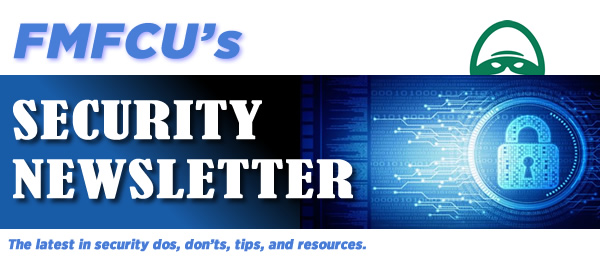 One hour check up = Peace of mind
One hour check up = Peace of mind
It’s time to review your most important web sites and apps you log into to make sure you’re taking advantage of all security features offered.
Web site security used to be just entering a username and password in a secure URL and away you went. Those days are long gone, and now these sites/apps have implemented new and improved security features to protect your personal information and even your finances.
FMFCU recommends setting aside one hour to make sure you’ve implemented as many of these new features as possible.
Hackers, using coding, and breached personal information taken from the dark web, are finding it easier to hack into your favorite web sites. So, the more barriers to entry you put up, the less likely they’ll break in and steal your personal information or even move money right out of your bank account.
Examples of web sites/apps you should review are:
- Email (Google, Hotmail)
- Social media (Facebook, SnapChat, Instagram, Twitter, LinkedIn)
- Banking and financial (FMFCU, Capital One)
- Home security and home automation (Nest, Ring, Amazon Alexa, Google Home)
- Online storage (Dropbox, Microsoft OneDrive, Google Drive)
- Gaming (Microsoft, Steam)
FMFCU’s RECOMMENDATIONS (DO AT LEAST THE FIRST 5):
1. Take advantage of alerts/notifications – Numerous web sites now have email or text notifications to let you know what’s going on with your account.
SUGGESTION: Head over to Settings or Preferences in your favorite web sites or apps and look for the Security settings. Turn on any relevant notifications like money transfers, balances, login info, social media alerts, and others. If your credit card offers it, turn on fraud monitoring to get alerts sent to your phone.
2. Multi-factor Authentication (MFA) – This is probably one of the most underutilized features that could easily save yourself from a fraudster. This extra step will typically send a code to your phone for another layer of protection before you can access your app or web site.
SUGGESTION: Turn on MFA where available and when possible, use fingerprint or FaceID for apps. Also check out authenticator apps like Google Authenticator or Microsoft Authenticator.
3. Get a password manager app – Say goodbye to remembering passwords. This app will store all of your usernames and passwords for your favorite sites. The only password you need is for the password manager! All of your information contained in the password manager is encrypted. Plus, it can create the strongest of passwords for your web sites and even automatically launch the web site you want and put in your encrypted credentials with one click.
SUGGESTION: Our favorite password apps – LastPass, Dashlane
4. Change those passwords – Stop using the same password for your internet web sites and apps. All it takes is for the fraudster to hack one of them and you’re potentially compromised everywhere.
SUGGESTION: Use a password manager (mentioned above) or create your own complex password (minimum 16 characters including upper/lower case, numbers, and symbols).
5. Secure your email – Email is where hackers poke around because a considerable amount of personal information about you is kept in here. Every major email provider has been hacked in the past, so it is a good idea to secure your email login.
SUGGESTION: Add multi-factor authentication (MFA) to your email client and use a complex password.
6. Review privacy settings – Take some time to review your device/desktop settings and app settings. Also make sure your operating systems are up to date.
7. Get your free annual credit report – Get your report once a year for free to look for anything suspicious or unexpected. You can obtain it at AnnualCreditReport.com
8. Update your apps – Make sure your device has the latest versions of apps. Many times the app is updated with security patches and added security features.

Leave a Reply